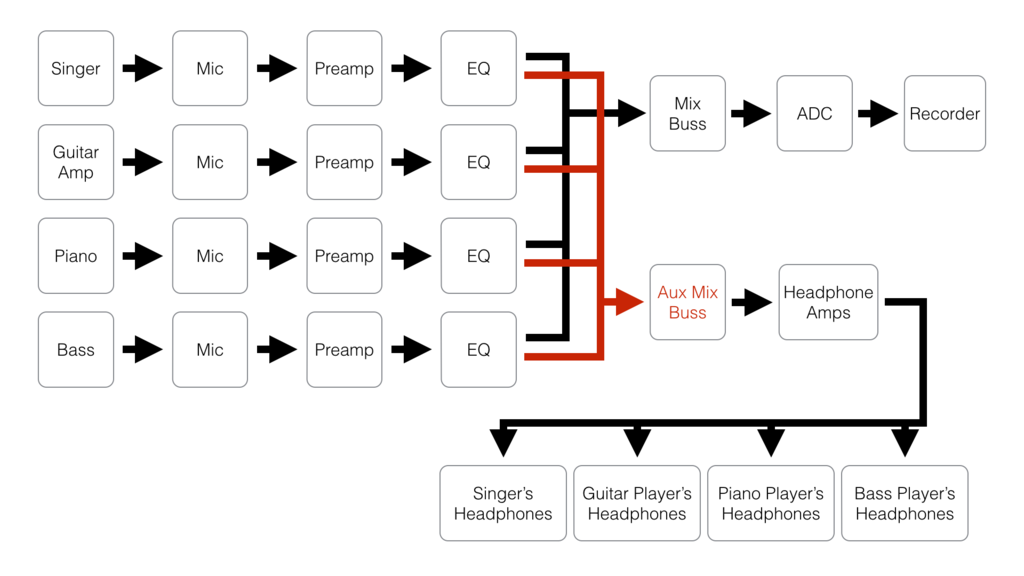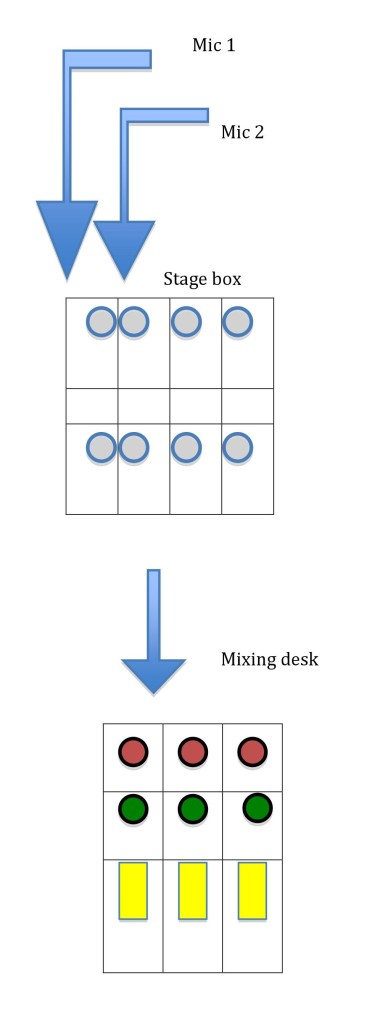
Signal Flow
In Yvonne’s Top 52 Tips To Remember, signal flow was one of the things I flagged as important, so I thought it might be a good idea to cover that in more detail. You have a bunch of awesome equipment, you have awesome musicians, and you need to get the sound from the musician or SFX playback computer through all that awesome equipment and out into the world or recorded in some way. Once you understand signal flow, troubleshooting will become a whole lot easier.
No matter how big the system is, the same principles of signal flow apply. If you are responsible for that system going together or responsible for keeping it working, then it’s important you understand the signal flow of that system.
Signal flow in relation to fault finding
Signal flow in its most basic form can be expressed as Fig. 1
.
Assume you have plugged mic one into line one on the stage box and line one is patched into channel one on the desk. Assume you have done the same thing for mic two – mic two to line two to channel two.
If you aren’t getting signal into the desk from mic two, and when you swap the mics the problem doesn’t move, you know the problem isn’t with the microphone. The signal from mic one to the desk works, the signal from mic two to the desk doesn’t. If the only thing you have done is swap the mics and the signal still isn’t getting to channel two, then the fault is further up the signal chain than the microphone. If you swap the XLRs between the mics and the stage box and the fault still doesn’t move, you know it’s further up the signal chain. Work your way up the signal chain swapping equipment until the fault moves. When you manage to get the fault to move, you will know which piece of equipment is faulty – or at least where in the signal chain the fault is likely to be. This is fault-finding in its most basic form. Sometimes a cable will start working again, though not for long because you touched it and made the dry solder or loose connection make contact.
Internal to the desk, the same principles of signal flow apply (Fig. 2). The signal flows from the input through the group or aux into the matrix and out of the desk. If you can follow the signal through the desk, then you should be able to find the fader that has been left down or channel that is muted, or where the fault is.
Signal flow in relation to monitoring when fed from the FOH desk.
Imagine you have a band with an Aviom or wireless in-ear system and a stage that you’ve put into different time zones. There is a DSM/show caller that needs to hear the vocals, a feed going off to archive, and the band and an offstage vocal booth who need to hear what’s happening on stage. Where in the signal flow do you tap off the vocal monitoring to feed the different needs of the listeners?
If you send the vocal feed from the radio mics pre-fader (i.e before the fader in the signal flow), the person listening will hear the cast offstage and in their dressing rooms. But if you want to send the feed off to multitrack or a broadcast truck where it will be mixed later, then pre-fade may be the correct think to do.
The band and the vocal booth aren’t going to want to hear the radio mics pre-fader; they will only want to hear the mics that are live to front of house. So you’ll want to send post-fade. But do you want to send it to the band/vocal booth direct from the channels or from the vocal group? If the vocal group has a changing delay time to allow for stage position, what would happen to the vocal booth if they were singing along to it? What would happen to the band if they had a feed that was time-delayed before it reached them?
Signal flow in system design
When using compression, where in the signal flow should it be: on an individual channel, on a group, or across the outputs? Do you want to EQ something that’s been compressed, or do you want to compress something that’s been EQ’d? The effect is different depending on which way round you do it.
Putting processing in different places in the signal flow can have very different results. If you needed to use EQ on a signal processed with reverb, should you EQ the aux send to the reverb, or should you EQ the return channels from the reverb back into the desk? There are no correct answers, other than what fits the situation at the time But understanding the signal flow will enable you to make better decisions in order to achieve the results you want.


